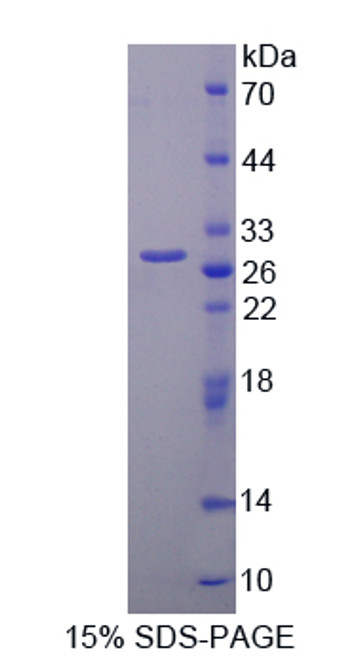Product Description
Human Phosphoprotein associated with glycosphingolipid-enriched microdomains 1 (PAG1) ELISA Kit | AE28788HU | Abebio
Species Reactivity: Human (Homo sapiens)
Abbreviation: PAG1
Alternative Name: CBP; FLJ37858; MGC138364; PAG; Csk-binding protein|phosphoprotein associated with glycosphingolipid-enriched microdomains
Application: ELISA
Range: 0.156-10 ng/mL
Sensitivity: 0.078 ng/mL
Intra-Assay: ≤4.5%
Inter-Assay: ≤8.2%
Recovery: 1, 02
Sample Type: Serum, Plasma, Other biological fluids
Detection Method: Sandwich
Analysis Method : Quantitive
Test Principale: This assay employs a two-site sandwich ELISA to quantitate PAG1 in samples. An antibody specific for PAG1 has been pre-coated onto a microplate. Standards and samples are pipetted into the wells and anyPAG1 present is bound by the immobilized antibody. After removing any unbound substances, a biotin-conjugated antibody specific for PAG1 is added to the wells. After washing, Streptavidin conjugated Horseradish Peroxidase (HRP) is added to the wells. Following a wash to remove any unbound avidin-enzyme reagent, a substrate solution is added to the wells and color develops in proportion to the amount of PAG1 bound in the initial step. The color development is stopped and the intensity of the color is measured.
Product Overview: PAG1 is a type III transmembrane adaptor protein that binds to the tyrosine kinase csk protein. It is thought to be involved in the regulation of T cell activation.Initiation of signal transduction via immunoreceptors depends on interactions of the engaged receptor with glycosphingolipid-enriched membrane microdomains (GEMs), also known as membrane rafts. GEMs are small signaling islets that are relatively resistant to detergent solubilization except by n-alkyl glycosides. Sequence analysis predicted that the 432-amino acid type III transmembrane protein contains a 16-amino acid extracellular domain, a 20-amino acid transmembrane domain, a putative palmitoylation site, and a 397-amino acid cytoplasmic tail with 9 potential tyrosine phosphorylation sites and multiple putative casein kinase II and protein kinase C phosphorylation sites.
Stability: The stability of ELISA kit is determined by the loss rate of activity. The loss rate of this kit is less than 5% within the expiration date under appropriate storage condition. The loss rate was determined by accelerated thermal degradation test. Keep the kit at 37°C for 4 and 7 days, and compare O.D.values of the kit kept at 37°C with that of at recommended temperature. (referring from China Biological Products Standard, which was calculated by the Arrhenius equation. For ELISA kit, 4 days storage at 37°C can be considered as 6 months at 2 - 8°C, which means 7 days at 37°C equaling 12 months at 2 - 8°C) .
 Euro
Euro
 USD
USD
 British Pound
British Pound
 NULL
NULL








